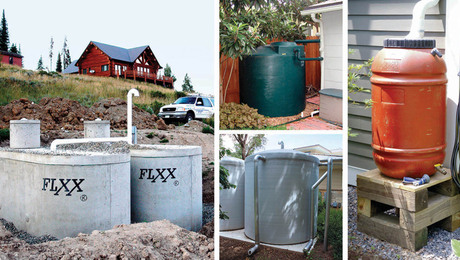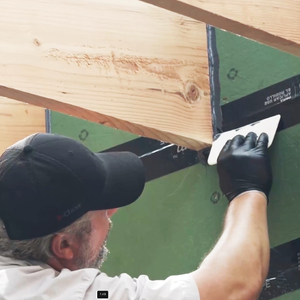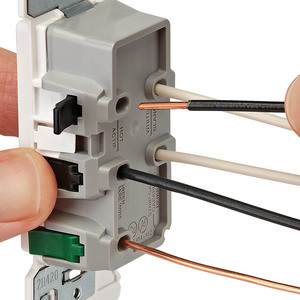I am a homeowner. I am contemplating having the the brick removed from our house (it is spaling badly after 80 years) and replaced with EIFS.
My question is in regards to how EIFS is installed in a retrofit situation with regards to existing window jambs. My jambs currently are inset from the brick face by 2-1/2″ (or 2-5/8″ from the house’s sheathing which is 1″x12″ old-growth pine boards incidentally).
I’ve looked at EIFS installations and the finish surface seems to be proud of the window jambs by at least an inch or two. If that were to be done on my house then the EIFS finish surface on my house would need to be 3-5/8″ to 4-5/8″ away from sheating. That seems awfully thick to me.
What would be the solution (other than removing windows are resetting them (which would require retriming them all on the inside)? 2″x lath over the house wrap before the foam? Any issues with leaving that 1-1/2″ space between the housewrap and the foam? Maybe it would actually be a good drainage plane just in case water does get inside?
Or, what about EIFS OVER existing brick? I don’t like the sound of that but maybe it is fine – what do I know!
Thoughts? Comments about this particular issue and EIFS retrofits on old residentials?
Thanks!
P.S. In case it is relevant with regards to vapour egress and compatibility with EIFS, the house has a retrofitted vapour barrier. It isn’t complete (no vapour barrier in the space occupied by floor joists – it is ballooned framed).
Edited 9/18/2006 11:04 am ET by e2canoe
Edited 9/18/2006 11:05 am ET by e2canoe
Edited 9/18/2006 11:05 am ET by e2canoe
Edited 9/18/2006 11:06 am ET by e2canoe


















Replies
Hmm, are you considering EIFS for its insulation potential, or for the flexibility of the final finish surfaces?
The 'why' of that, is that you could simply stucco over the existing brick (after applying lath screwed to the mortar joints, etc.).
Bringing "just" stucco back as the returns is likely the best way to handle your window trims situation (possibly)--I'd not "bury" existing trim under the stucco, naturally.
Posting some photos and/or sketches might be very helpful.
(Oh, and be prepared for much vitriol on the "innate" unsuitability of EIFS is any residential situation--a position I disagree with.)
Considering EIFS for the following reasons:
1. Aesthetics, 2. Maintainability (no painting of wood siding), 3. Ability to build up to produce exterior returns to window jambs.
The insulation (sound and cold) are just bonuses.
Re: vitriol. Yes, I expect a lot. Must admit that I'm kinda skiddish about putting EIFS on my house. Even if the water infiltration issues have been solved with training and better systems I'm worried about reselling the house. All it takes is a buyer's building inspector to say "Stay away! EIFS!".
I like stucco since it tried and true but will the lath be okay over brick that is badly spalling?
but will the lath be okay over brick that is badly spalling
Well, I'm assuming that whoever installs the lath would also take and insure that all the "loose" bits were raked/brushed/scaled off before locking the lath down.
Putting the lath fasteners into the mortar joints also is anchoring the lath to the joints, rather than the (potentially) loose faces of the brick. The brown coat (ought to) then be fairly contiguous, like a parged coat tends to be.
Mostly, I was thinking of not having to skin the brick out with hard to find 1/4 or 1/2" EIFS-rated foam sheets. Not only would they be a pain to get, they'd be a pain to fasten up. That, and adding to your "depth issues" seemed a bit backwards.
Have any of the bricks spalled off enough to let you see if they are face or if they common bricks? I'm guessing they are face bricks, and that's why they are spalling. Face bricks are really a hard crust over a softer core. Makes for a nice very-low maintenance exterior finish--until they wear out or are otherwise compromised.Occupational hazard of my occupation not being around (sorry Bubba)
in your list of reasons why you chose EIFS, I didn't see price as a factor.
as a result, would you consider putting brick back on the structure ? it is the best choice, but also the most expensive. I would bet that it wouldn't be that much different from an EIFS application with thick foam that simulated the thickness of your bricks. you should consider this as an option.
i don't think i would remove the brick to install EIFS. in fact, i don't think EIFS should even be considered for this repair at all. and i actually like EIFS.
it's just that hard coat stucco makes more sense. as the Capn said earlier, galvanized wire lath is mechanically fastened to the bricks and then stucco is applied. an acrylic based finish is applied over the base. an installer in our area has been doing this since the '30's, but they didn't always use the wire lath.
unless the bricks are in really awful shape, going over them with stucco shouldn't be a problem.
carpenter in transition
I didn't include price in the list but actually I DO have a budget and brick will make it tough to stay within budget. Plus, bricklayers in this area (Ottawa, Canada) are in big demand so prices are extra high.
My wife actually prefers the look of stucco over EIFS so it sounds like stucco is a great choice. I thought it wasn't possible to stucco over spalling brick so I didn't consider it. I'll take a couple of pictures of the bricks' condition and will post. I must say that the mortar joints are in pretty good shape except for the ocassional crack here and there.
And the bricks are common bricks. So-called "wire cut" (ugly in my opinion). I'd love to rebrick with smooth faced bricks but suspect this would blow our budget as I said.
How would the returns be handled with stucco? Would bricks be removed around the openings to allow lath and stucco to be placed?
P.S. Timkline, I just noticed you said "acrylic" stucco. I thought all stucco was cementatious (I think I made up that word). Are you taking about using EIFS finish over lath (diamond lath?)?
Edited 9/18/2006 5:22 pm ET by e2canoe
Edited 9/18/2006 5:22 pm ET by e2canoe
no, the bricks around the openings are not removed, they just get stuccoed.
yes, you lose opening width, about 1/2" on each side.
the base coats are standard cementitious stucco.
the finish is acrylic:
http://www.manningmaterials.com/flexlite.html
carpenter in transition
Thanks for the information everyone. I think it's gonna be stucco!
And of course, just now I can't find them, but you detail the window & door returns so that the trim is re-fit to the returned stucco. I have on one of these stinkin' puters somewhere, a nice retrofit/remodel detail using 1/4" cementitious (no you did not make that up <g>) board to make a nice, flat, base to sweep the stucco back to a control joint that the trim comes up to.
And Tim is correct, almost all stucco is acrylic-modified, the how much varies. The much-vilified "synthetic stucco" actually suffered for not being acryic-modified enough in some cases.Occupational hazard of my occupation not being around (sorry Bubba)
How about using a polystyrene panel with a flexible thin concrete coating attached to the brick.
I'm not sure I understand what you are suggesting? Are you saying to use acrylic based finish coat over thin foam and without a base coat in order to minimize overall thickness?
In any case, I would never spec a particular 'modified' technique. I would rely on a reputable local stucco or EIFS expert to recommend something. But before I went to them I wanted to get breaktime advice on the route to go in general and whether it was even possible.
"coatman" nickname... As it EIFS or stucco? :)
There are thin concrete coatings that have the concrete and co-polymers together. This interne gives your foam a rigid, tough exterior.
Oh OK. Thanks. As it turns out it sounds like the way to go is stucco over top of the existing brick. I like that since it saves the cost of tearing down the brick and stucco is cheaper than EIFS anyways. Bonus is that I don't have recurring nightmares about some weird and awful molds growing behind the foam and rotting my house from the outside in ;)